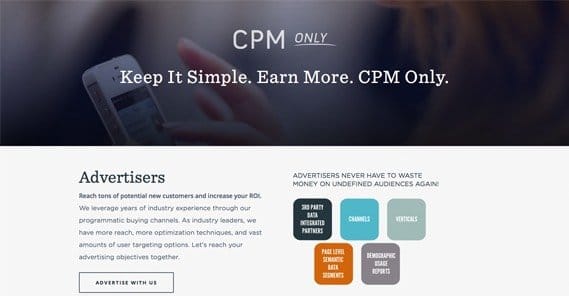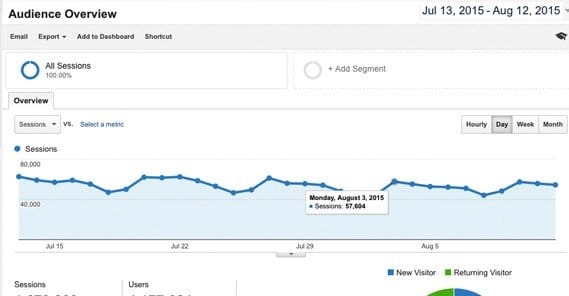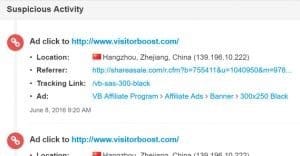How to Get Paid Per Ad View Instead of Per Click

In the world of online marketing, when you’re running ads on your blog, there are a few different ways you can get paid.
- Affiliate sales. These involve you running ads that refer users to a store, where they can buy items. You get paid if they buy.
- Lead generation. This is very similar to affiliate sales, except you refer people to communication with sales staff. The sales staff pay you for qualified leads – that is, people likely to buy, rather than people they can’t contact or fake information.
- Pay per click. These ads sit there on your site and do nothing until they’re clicked. You get paid a small fee each time the ad is clicked by a real user. Again, it only works if the user is real, bots and repeated spam clicks from the same person don’t count.
- Pay per impression. These ads sit on your site and earn you money every time they’re displayed to a real, non-repeat user. The more traffic you have, the more you can make. Because a view is so much easier than any of the above to get, these ads tend to pay a meager fee for view counts in the thousands.
Pay per impression is the easiest and least effort way to get paid for running ads on your site, hands down. The user doesn’t even need to pay attention to those ads; as long as they don’t have an ad blocker installed, they see the ads, and thus you get paid.
Because it’s so easy to get views, pay is scaled per thousand. For pay per click ads, you have a rate per click you earn. For pay per impression ads, you have an amount you earn per thousand views.
Impression advertising is often abused, unfortunately. There are dozens of traffic bots out there that claim to get around filters and work for various programs. For this reason, most of the ad networks out there – including the big one, Google AdSense – rely on a per click model.
Here’s the thing about AdSense. There are a lot of references out there to CPM advertising through AdSense. In the old days, running AdSense ads on your site was almost always a CPM – impression – payout. These days, though, very few companies want to pay for unqualified, random impressions. Instead, they want to pay for clicks or leads. Because that’s the case, AdSense ads are almost always CPC.
If you want to switch to CPM ads, you’re going to have to drop AdSense. Some ads will occasionally run CPM through AdSense, particularly when using graphical banner ads, but those are rare. You also can’t control it; it’s determined by Google. Or, rather, it’s determined by the people using Google AdWords to pay for ads; they determine whether they want to pay for clicks or impressions, and that determines how the ads on your site run.
CPM Vs. CPC
I understand the desire to not have to worry about sales or clicks, and just make money from your traffic seeing your content. It’s a good idea, and the only thing that makes it difficult is the longtime abuse of the system. For over a decade, CPM has been ruined by people running software or gaming the system in order to make a few bucks. They make theirs, but they trash the system for everyone else.
Consider a situation where your site pulls in about 1,000 visitors per day.
With CPC advertising, say you have a 1% click-through rate. For 1,000 visitors in a day, that’s 10 clicks.
With CPM advertising, your click rate doesn’t matter. 1,000 visitors is 1,000 impressions.
Now, with CPC, say you’re getting $1 per click. With CPM, you might be getting $2 per thousand impressions. Now look at the examples above. With 10 clicks per day, at $1 per click, you’re making $10 per day. With CPM, 1,000 daily views at $2 per thousand means you make $2 per day.
It’s also arguably easier to grow your click-through rate than it is to grow your traffic legitimately. That said, through the use of traffic purchasing, cheap ads, and taking advantage of viral traffic, you can boost your traffic in the short term a lot more than you can boost click rates.
Ads in different channels also have different values. According to MonetizePros, last year the value ranged from $2.80 per thousand views for standard display ads, to $5 per thousand views for ads within emails.
There’s a lot of variation in the industry, however. It tends to have a lot to do with niches and keywords, as well as ad placement. Video ads can be much more lucrative, for example. Consider this: the more traffic a niche has – the larger it is – the lower your CPM payouts are going to be.
Why is this? Think about it from the side of the business paying for the ads. If you’re in a broad niche, like video games or health food or exercise, it’s really easy to get a lot of traffic. You don’t want to pay a ton for the traffic, because there’s so much of it you’d lose out. On the other hand, in a very narrow niche with very little traffic, you’re willing to pay more for it because you can do more with it.
CPM in general isn’t all that widely used these days. Most of the people using it tend to be running sites where they don’t care about the quality of the traffic; they have ways to monetize it that exploit loopholes or don’t require user actions. They don’t want to spend a lot, so they go for CPM over CPC. What that means is that, more so than the low payments, the primary point of failure with CPM ads is the quality of those ads and the sites they advertise.
Investing in CPM
If you want to get paid via CPM despite all of the arguments against it, you’re going to have to monitor your inbox and prove yourself. There are two ways to do CPM.
- Join a CPM ad network, or a hybrid network that allows you to choose.
- Attract the attention of an agency that represents a private CPM network.
The former is the route most CPM publishers take, while the latter is the more lucrative and difficult of the two options.
Before I go into dealing with agencies and private networks, let’s first talk about the public CPM networks.
The primary problem with public CPM networks is, as I’ve mentioned, the quality of the sites and site owners involved with the network. A network is only as good as the people paying into it and the people running its ads. A lot of the sites on both sides of the equation for pure CPM will be bottom of the barrel, low budget, maybe even spam sites. The networks make money from a commission, but both the payments and payouts are minor, so they have to thrive on volume. Therefore, they don’t regulate or vet their publishers or advertisers very strictly.
If you’re interested in a public CPM network, here are some options for you to explore:
Each of these has benefits and drawbacks. Technorati is simple and focused on CPM ads. Rhythm One is a more modern rebrand of an older network. Conversant is a hybrid with affiliate and CPC ads as well. Tribal Fusion is one of the oldest remaining ad networks and advertises higher than average rates. I’ll leave it to you to investigate each of them and see if your site fits with their requirements.
Speaking of requirements, you might not get into all of these networks on the first attempt. See, for CPM to be lucrative, you need volume. You need a lot of traffic. Some will have higher requirements than others, but they don’t always publish them publicly. You’ll have to do some digging, contact account reps, or just apply and see if you qualify.
CPM Agencies
CPM agencies represent private CPM networks. Private networks have a lot of benefits where public networks don’t. Primarily, because they carefully vet their clients and publishers, they can maintain a high level of quality for both sides. They will only work with you if you refer a high volume of great traffic. Likewise, they only work with advertisers who have real, good products to advertise, who stay within the quality boundaries, and who have budgets to pay a reasonable rate.
That’s the single biggest benefit of a private network; the money. With the higher level of quality comes higher per-thousand rates.
Agencies will typically approach you, not the other way around. Therefore, in order to contract one, you need to become noteworthy enough to attract their attention. This means publishing quality content, attracting a sizable audience, and making it easy for them to contact you. It also means combing through your spam emails, because a lot of times the sort of messages these agencies send will trip spam filters. Be very careful! Always investigate a network before you sign any contract or implement any code, just in case they’re trying to pull a fast one.
Quality is very important because in an agency-run private network, there’s oversight on both sides. You will have veto power over the ads that run on your site, so you can stop ads that you deem too irrelevant or negative for your brand or visitors. Likewise, advertisers will be able to decline your site as part of the sites running their ads, for any of the same reasons.
In exchange for all of the vetting and service the agency provides, it will take a steep cut from the payments coming from advertiser to publisher. You could expect that if an advertiser is paying $10 per thousand views, you’re getting $5 per thousand, with the agency taking the rest. While this seems steep – and 50% is no joke – public networks often start with $2 per thousand from the advertiser and go down from there.
CPM as Supplemental Income
Here’s the thing. Imagine a scenario where you get in a premium private ad network, and you manage the impossible by getting a 100% fill rate – that is, always ads displayed – with those high value ads. You’re getting $20 per thousand views. Now, you want to make a living from your site, and this seems like a good setup. How many visitors do you need to make $1,500 a month? You would need 75,000 views per month, all of them qualified.
This is an absolute best-case scenario. You might be able to pull it off, but it will take a lot to manage anywhere near that amount of money for CPM. You’re more likely to be operating with CPM payments closer to $2 per thousand views. In which case, you would need 750,000 views per month; a much less feasible number.
No matter how good your traffic or how high your volume, you’re going to be making money in some other way as well if you want to be bringing in decent paychecks. You’ll be running CPC ads on the side, or selling memberships to premium content, or selling ebooks. The possibilities are endless, though they all take a lot of work.
CPM is, and always will be, supplemental income. It’s just too hard to monetize views for any reasonable amount of money, at least without significant investment first.
Making Yourself More Attractive for CPM
If you’re trying to attract a CPM agency, or just trying to get into one of the more exclusive CPM networks, you have some work to do.
The number one thing you want to do is get more traffic, but you need to get it legitimately. You can’t go out and buy traffic to make your numbers look better; chances are the traffic you’re buying is more expensive than the money you’d be making with the CPM ads, so you’re just losing out. You also can’t game the system with bots; they’ll be caught and you’ll be removed from the platform with your payments withheld. Beyond sheer traffic volume, though, there’s more you can do.
Expand within your niche so you can cover as much ground as possible, to attract advertisers with interests that may not align 100% with your own, but are close enough to be reasonable on at least some sizable portion of the content on your site. You won’t be able to go full-on generalist blog, not even the biggest blogs alive do that, but you can probably stand to expand somewhat beyond what you’re currently covering.
Experiment with the ability to place ad units in unconventional locations. If you run videos, you can use video ads on any video you don’t host directly on YouTube. If you have a responsive design or a dedicated app, you can run mobile or app units, which typically pay more than just your basic website ads. You can even consider opening up a slot for ads in your mailing list newsletter.
You should also strive to put ads in places where they’re most visible. A banner ad at the top of the page is going to earn you more than a banner ad in your footer. It’s more of an algorithmic thing; when the page loads it counts a view one way or the other, but the network or agency sees that the ad is hidden out of the way and thus gives you less for it.
Don’t over-do it with ads. The more ads you have, the spammier your site looks. I know with the low value of CPM it’s easy to think you can double your revenue by adding a second ad to a page, but that kind of thinking will eventually drive away users and earn you a search penalty. It s a technique used by spam sites and you don’t want to look like you run with that crowd.
Finally, do what you can to supplement your CPM income with other forms of income. The more reliant you are upon meager payments, the more you’re going to go out of your way to focus on them, and the more likely you are to accidentally do something that hurts you. I don’t care if you have to sell ebooks, run consulting, or make a member’s section of your site; you need a second source of income if you want to be able to grow CPM naturally.
 ContentPowered.com
ContentPowered.com









Very cool. Useful for sites with lower engagement I guess